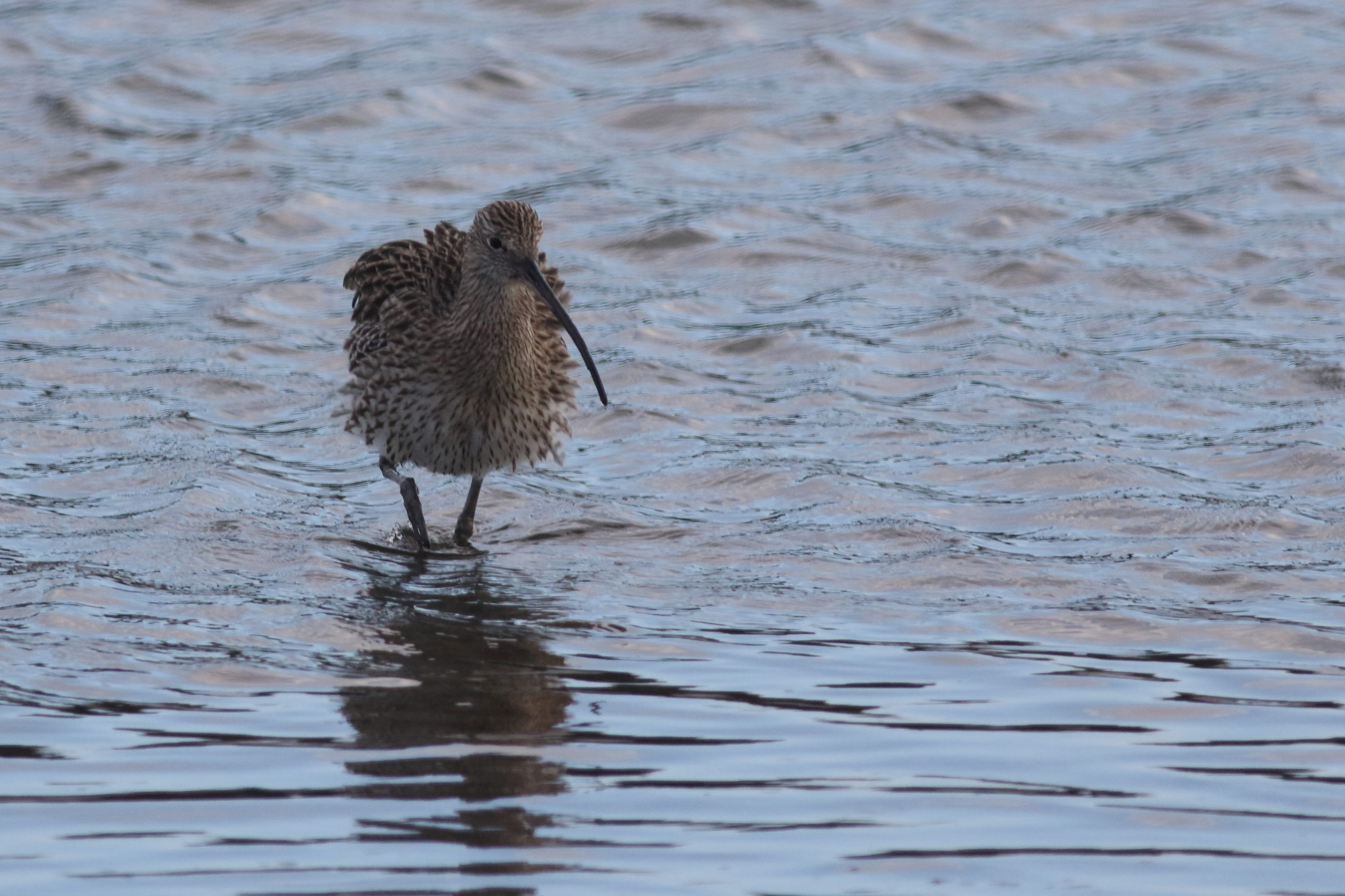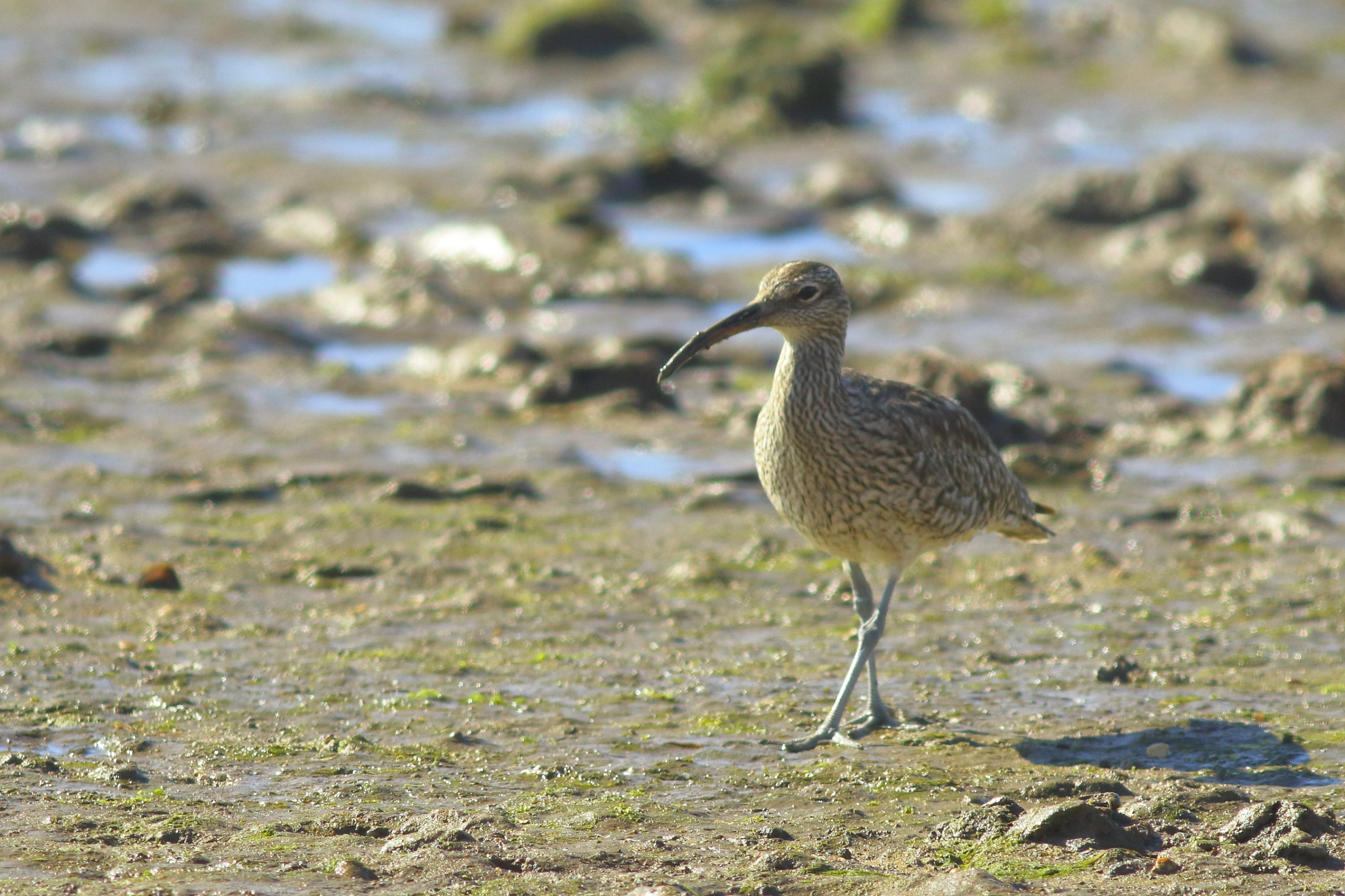by Sally Westwood
Curlew (Numenius arquata)
The tide was ebbing, almost at low tide, it was about an hour before sunset. The Deben was embellished with a clear, magical light that appears just before sunset and sunrise. Such a light produces enhanced clarity of detail in everything visible to the eye. Two Curlews1 landed on the mudflat, one each side of a gully of water draining into the shallow channel of the river. Curlews are the largest waders in the UK, with a streaked and barred plumage, long legs and a distinctive down curved bill2, see image above. In flight, it shows a white section on the rump. The Whimbrel3 by comparison, is a similar bird to the Curlew, except it has a shorter, thicker bill, with a narrow stripe on the crown and is smaller than the Curlew, see image below. In flight, it shows a white section on the tail and back. I was alerted to the Curlew’s presence from their distinctive “Curlew, Curlew’’ calls made when they were flying. It is a call I regard as haunting in the cold, overcast days of winter. They also have a trembling, evocative bubbling call, that ends with what may be described as “dude” which carries some distance. One Curlew joined the other, on the other side of the gully. They immediately started squabbling, poking their long slender, down curved bills at each other, raising their wings slightly. Moments later, the set too ended when one returned to the other side of the gully and started searching for food, poking its bill, deep into the mud. The other Curlew started bathing and shaking out feathers, as in the image above. They may have been a pair, or an adult and youngster, however, research on Curlews has indicated that the latter relationship may be unlikely4. Since Curlews in England and Wales are in decline and such decline is driven by factors occurring during the annual breeding season.
Whimbrel (Numenius phaeopus)
The current UK population of Curlews is 25% of the total world population5. It is estimated that the European population of Curlews stands at 212,000-292,000 pairs and is believed to have decreased by as much as 30-49% over the last 30 years6. Consequently, Curlews have been classified as vulnerable to extinction on the Red List of Threatened Birds7 and from a global perspective the Curlew is also considered to be near threatened8. A BTO bird survey carried out a count of Curlews present during the winter of 2019-2020 on the Deben estuary9. The survey stated that the peak amount of the species during one month was 623, the average presence per month was 385, and the average density was 0.53. The previous survey conducted during the winter of 2013-14 showed higher numbers of Curlews in the Deben estuary. The peak amount of the species during one month was 729, the average presence per month was 378, and the average density was 0.56.
The decline in Curlew numbers was initially thought to be linked to their winter grounds. Most Curlews that winter in Wales and England are present on estuaries. Prior to the 1980s, it was thought that the decline in Curlews derived from deficits in their wintering grounds, like the Deben which might have had a negative impact on their population10. Deficits may have stemmed from the water quality, cold winter weather, and river morphology factors including the composition of banks and beds, the presence of sediment in the water and the rate of the deposit of the sediment, that may alter the shape of the bed and floodplain10. However, research analysis has suggested that the introduction of a hunting ban in 198211 increased the count of Curlews in their wintering grounds after the 1990s , by contrast there has also been a decline in Curlew breeding populations since that time12. As a consequence, it is thought that factors that have occurred during the breeding season have had a negative impact on the breeding success of Curlews, rather than factors associated with estuary water or cold weather.
Curlews nest on moorland, wet grassland and bogs, such as in the Peak District National Park13. Curlews tend to remain faithful to one nesting site and are not adaptable. Curlew are raising 0.25 chicks in each nest, however, to reverse and stabilise the decline in Curlew numbers, the number of chicks would need to increase to a level of 0.43 in each nest14.
There are several reasons why Curlews are disappearing. Changes in habitat including intensive farming, such as reseeding, and the loss of wet grassland, such as land drainage have had an adverse effect on the Curlew. These two factors has produced a reduced quality of habitats suitable for breeding for the species15. Rural environmentally friendly farmland is helpful for Curlew breeding success, however, predators also have an negative impact on breeding success16. The RSPB has indicated that increase in predator populations, such as crows and foxes have contributed to Curlew declines (RSPB, n.d.), as have stoats and weasels17.
Recents efforts have been made to reverse the decline of the Curlew. The Wildlife Trusts work with landowners and farmers to ensure the Curlew is protected and to encourage wildlife friendly practices that benefit the Curlew18. Another positive project commenced in 2015, involved the head starting of Curlew chicks by Curlew Country19 in the Powys borders and Shropshire hills. Headstarting chicks is a project to save Curlew chicks as a temporary measure until more permanent measures are arranged to save chicks. The website has a webcam which provides viewing of the Curlew rearing pens and the curlew chicks. The project has asserted the two prerequisites that Curlews need, firstly they need predation control, and secondly, farmers who are supporting breeding waders need agri-envionment support. The head-starting project is a temporary method to save the Curlew until these two prerequisites are set up. The Curlew Country 2018 Report stated that 21 chicks were successfully released into the wild from 54 eggs that had been gathered from nests in the wild. Natural nests of three pairs of Curlews resulted in only two well fledged youngsters. Tags found from fours chicks from other pairs, suggested avian predation. Mammalian predators were also thought to be a determinant of loss of chicks. The Curlew Recovery Partnership20 is an organisation that provides support and coordination to those groups involved in Curlew conservation. This organisation was the outcome of Curlew Recovery Summits introduced by His Royal Highness The Prince of Wales in 2020.
Wader Tales is an excellent website if you are interested in reading about Curlew research and blogs or the information about the routes of ringed and tagged Curlews on migration. Curlews in East Anglia, for example have travelled to Poland, France and Finland20.
We can be mindful of the Curlew and all waders, when we are walking along the river bank, sailing in our boats on the river, or canoeing, or kayaking, or paddle boarding. Incidentally, when describing the nature and location of the Deben estuary the BTO bird survey stated in relation to the Deben estuary that ‘recreational activities such as sailing and water sports are perhaps the most obvious sources of disturbance on the site’ 21. The River Deben (RDA) has published guidance for when we travel along the river, specifically that we keep a distance from roosting, feeding and breeding areas twelve months of the year. If birds fly as you approach or pass them, you may be too close and cause them stress, and this might have a negative impact on waders’ ability to survive. The RDA has published several useful maps displaying sensitive areas of the river that must be avoided 22.
It seems that predators, such as crows, foxes, stoats and weasels have contributed to Curlew decline in their breeding areas23, however, disturbances on the river, such as kayaking or paddle boarding may also contribute to their decline in this country. Since such disturbances may well put Curlews off from overwintering on the Deben, they may decide to winter elsewhere in the country, or if they migrate they may prefer to remain abroad. That would be a sad loss of this elegant bird. Since Curlews are declining globally it makes sense to do all we can to ensure that both their breeding habitat and winter habitat on estuary areas, like the Deben remain safe from disturbance and free from predation.
Sally Westwood
Sally Westwood is a Psychologist, and works as a researcher. She has taught in higher education as an English Language teacher. Her interests are varied. She has written many articles for Bird Magazines and Journals. She is also a professional bird photographer. Birds are her passion. She loves to draw and paint birds. She lives on a boat on the Deben and loves to sit and be with the birds, simply watching and photographing birds, in their daily activities.
Footnotes
1 Numenius arquata
2 Peak District National Park Authority, 2021
3 Numenius phaeopus
4 Woodward, I., D., Austin, G., E., & Boersch-Supan, P., H., (2022) Assessing drivers of winter abundance change in Eurasian Curlews Numenius arquata in England and Wales. Bird Study. DOI: 10.1080/00063657.2022.2049205.
5 British Trust for Ornithology, (2022) Assess drivers of winter abundance change in Eurasian Curlews Numenius arquata in England and Wales. Available from:
https://www.bto.org/our-science/publications/peer-reviewed-papers/assessing-drivers-winter-abundance-change-%C2%A0eurasian [Retrieved 22 July 2022].
6 Jiguet, F., & Bocher, P., (2021) Investigation into the illegal killing of a tagged Eurasian Curlew. Forensic Science International: Animals and Environments, 1,1-7.
7 International Union for Conservation of Nature and Natural Resources. (2015) The IUCN Red List of Threatened Birds. Version 2015.1. Available from: https://www.iucnredlist.org [Retrieved 22 June 2022].
8 Curlew Recovery Organisation. (2022) The Curlew Recovery Partnership England. Available from: https://www.curlewrecovery.org/about-us [Retrieved 19 July 2022].
9 Frost, T., M., Calbrade, N., A., Birtles, G., A., (2021) Waterbirds in the UK 2019/20: The Wetland Bird Survey. BTO/RSPB/JNCC. Thetford.
10 British Trust for Ornithology (BTO), (2022), as above.
11 Woodward, I., D., Austin, G., E., & Boersch-Supan, P., H., (2022), as above.
12 Taylor, R., C., & Dodd, S., G., (2013) Negative impacts of hunting and suction-dredgimg on otherwise high and stable rates in Curlew Numenius arquata, Bird Study, 60(2), 221-228.
13 Peak District National Park Authority. (2021) Climate Change Vulnerability Assessment. Available from: https://reports.peakdistrict.gov.uk/ccva/ [Retrieved 22 July 2022].
14 Cook, A., S., C., P., Burton, N., H., K., & Dodd, S., G., (2021) Temperature and density influence survival in a rapidly declining migratory shorebird. Biological Conservation, 260, doi.org/10.1016/j.biocon.221.109198.
15 Wader Tales. (2020) Curlews and foxes in East Anglia. Available from: https://wadertales.wordpress.com/2020/02/24/curlews-and-foxes-in-east-anglia/ [Retrieved 21 July 2022].
16 Cook, A., S., C., P., Burton, N., H., K., & Dodd, S., G., (2021), as above.
17 RSPB. (n.d.) Curlew Conservation. Available from:
https://www.rspb.org.uk/birds-and-wildlife/wildlife-guides/bird-a-z/curlew/conservation/ [Retrived 23 July 2022].
18 Wildlife Trusts. (2022) Curlew. Available from: https://www.wildlifetrusts.org/wildlife-explorer/birds/wading-birds/curlew [Retrieved 21 July 2022].
19 Curlew Country. (2022) Curlew Recovery Partnership England Headstarted Curlew Chicks. Available from curlewcountry.org [Retrieved 21July 2022].
20 Wader Tales. (2020), as above.
21 Frost et al., (2021), as above.
22 The RDA has published useful maps and these are available from www.riverdeben.org
23 RSPB. (n.d.) Curlew Conservation, as above.


